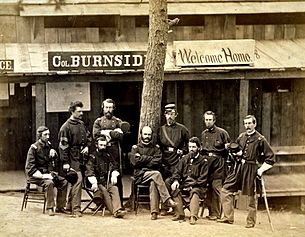Isaac P. Rodman facts for kids
Quick facts for kids
Isaac Peace Rodman
|
|
|---|---|
 |
|
| Born | August 18, 1822 South Kingstown, Rhode Island |
| Died | September 30, 1862 (aged 40) Sharpsburg, Maryland |
| Place of burial |
Brigadier General Issac P. Rodman Lot, South Kingstown, Rhode Island
|
| Allegiance | United States of America Union |
| Service/ |
United States Army Union Army |
| Years of service | 1861–1862 |
| Rank | |
| Unit | 2nd Rhode Island Infantry Regiment |
| Commands held | 4th Rhode Island Infantry Regiment 3rd Division, IX Corps |
| Battles/wars | American Civil War - First Battle of Bull Run - Battle of Roanoke Island - Battle of New Bern - Battle of Fort Macon - Battle of South Mountain - Battle of Antietam † |

Isaac Peace Rodman (born August 18, 1822 – died September 30, 1862) was an important person from Rhode Island. He worked as a banker and also served as a politician. During the American Civil War, he became a Union Army brigadier general. Sadly, he was badly hurt during the Battle of Antietam and died from his injuries.
Contents
Early Life and Career
Isaac Peace Rodman was born in South Kingstown, Rhode Island. His parents were Samuel Rodman and Mary Peckham. He married Sally Lyman Arnold, whose father, Lemuel Hastings Arnold, was once the Governor of Rhode Island. Isaac's brother-in-law, Richard Arnold, also became a general in the Civil War.
Isaac worked with his father and brother in a business called S. Rodman & Sons. He was also the president of the town council in South Kingstown for many years. A town council is a group of people who help run the local government. He also served several times in the Rhode Island General Assembly, which is like the state's parliament, and in the Rhode Island Senate.
Besides his political roles, Isaac was a director at the Wakefield Bank and the Institution for Savings. He was also a very religious person. He taught a Bible study class and was in charge of a Sunday school.
Service in the Civil War
When the Civil War began, Isaac Rodman faced a tough choice. He was a man of peace because of his religious beliefs, but he also felt very loyal to the Union. In the end, he chose to support the Union. He quickly gathered a group of local people to join the 2nd Rhode Island Infantry Regiment. He was made a captain in this group.
His regiment fought in the First Battle of Bull Run, which was one of the first big battles of the war. They were part of a larger group led by Brigadier General Ambrose Burnside. The regiment lost many soldiers in this battle, including their colonel.
Leading the 4th Rhode Island Infantry
After the battle, on October 3, 1861, the Governor of Rhode Island, William Sprague, made Isaac Rodman the colonel of a new group called the 4th Rhode Island Infantry Regiment. He continued to fight under General Burnside in North Carolina. They fought in the Battle of Roanoke Island and then in the Battle of New Bern. Isaac showed great bravery in these battles. Because of his courage, he was promoted to brigadier general on April 28, 1862.
After the Battle of Fort Macon, Isaac got sick with typhoid fever. He had to go home to South Kingstown to get better.
Return to Battle and Final Days
While Isaac was still recovering at home, General Burnside wrote to him. Burnside told him that they needed officers for an important upcoming battle in the Maryland Campaign. This was when Confederate General Robert E. Lee was trying to invade the North for the first time. Even though he was still sick and his doctor told him not to go, Isaac returned to the army after only a few weeks.
In the Battle of South Mountain, he led the 3rd Division of the IX Corps. Their job was to capture an area called Turner's Gap. During this attack, the commander of the IX Corps, Major General Jesse L. Reno, was killed. Jacob D. Cox took his place.
Three days later, on September 17, 1862, came the Battle of Antietam. Burnside's corps was ordered to attack the right side of the Confederate army. This was on the hills south of Sharpsburg. The soldiers were delayed trying to cross a heavily guarded bridge over Antietam Creek. This bridge is now known as Burnside Bridge.
Burnside sent Isaac Rodman's 3rd Division to find a place to cross the creek further downstream and attack the enemy from the side. No one in the army had checked this crossing spot before. They found out too late that it was too difficult to cross because of its steep banks. Rodman's men spent three hours looking for another place. They finally crossed Snavely's Ford, two miles further downstream, at 1 p.m. By this time, the Burnside Bridge had finally been taken.
Rodman's corps then moved quickly towards Sharpsburg. But at 4:00 p.m., a Confederate group led by A. P. Hill arrived and launched a strong counterattack. Isaac Rodman saw the Confederates coming. He knew his division, which was on the far left side of the Union army, would face the main attack. He rode quickly across a cornfield to warn his commanders. As he did, he was shot through his left lung. He was badly wounded and died thirteen days later in a hospital near Sharpsburg.
Legacy and Burial
Isaac Rodman is buried in the Rodman family cemetery in Peace Dale, Rhode Island. His old home, the Gen. Isaac Peace Rodman House, was added to the National Register of Historic Places listings in Washington County, Rhode Island on April 23, 1990.

